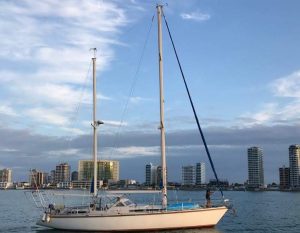Covid-19 Field Report: Our yacht trapped in Ecuador – us in Peru
On March 3, after prepping for our passage to Chile, Stephan and I left Hanalei at anchor with a caretaker in Salinas, Ecuador, and flew to Perú for what was meant to be a two-week visit. On March 15, two days before our return flight, both Perú and Ecuador locked down. We were not able to get back to our home for 6 months.
Published 4 years ago


- Hanalei at anchor in Salinas, Ecuador
Because we were neither residents nor citizens of Ecuador, the only repatriation flights available to us were to the U.S.
Hanalei’s temporary import (in Ecuador) was good until the end of April, so we decided to wait in Perú until the border re-opened.
On March 30, I contacted the service desk of Ecuadorean Customs to explain our situation. I was told only that paperwork had been suspended until the state of emergency was lifted, after which time foreign vessels would have 30 days to arrange an exit zarpe. No end date was given for this suspension of tramites. I repeatedly contacted them–the only section being staffed during the suspension–to ask for clarification. I received none.
Even with an exit zarpe, leaving Ecuador would have been nearly impossible. Entry of foreign-flagged maritime traffic–with the exception of commercial vessels– was prohibited in Chile, French Polynesia and Panamá.
I requested an emergency extension to our temporary import and submitted scans of all our paperwork. The service desk responded that import of a vehicle required verification by immigration authorities of our right to be in Ecuador, which presumed we were already in the country.
Lockdown extended:
The initial two-week lockdown stretched into months.
I requested information from Diana Jose, the Puerto Lucia Yacht Club facilitator who had done our clearance into Ecuador the previous April (as did the captains of two other foreign-flagged boats on the hard there who are trapped in the U.S. and Australia). No response.
We were evacuated from Peru to the U.S. on May 15.
I informed Ecuadorean Customs we would return to Hanalei once flights resumed and enquired about our status. I received no response.
On June 15 I again enquired about our status and the end date for suspension of tramites. I was told I needed to write a letter to a different section, which I did.
On August 4, after again asking about my status and that of the suspension of tramites, I was sent a screen shot indicating that as of June 16, officer Byron Amores was processing my request.
In early September, I engaged an attorney who worked with MACOBSA, a marine agent and Customs specialist. Flights to Ecuador had resumed, but the attorney thought it wasn’t necessary for me to appear in person. Despite a month or so of promised meetings and enquiries, he made no progress.
In mid-October I reached another attorney with shipping agent connections. A week later, she reported that the suspension of tramites had, in fact, been lifted on June 15; Hanalei had overstayed her temporary import and was incurring fines of $400/day; Customs was taking steps to seize the boat. She had no idea how long that process might take.
The most ominous news was that the shipping agent had declined to intervene on Hanalei’s
behalf.
I didn’t see any good ending to this story.
Finding a solution:
With two days’ notice, my son and I flew to Ecuador. It took a few hours to provision and board water, but winds would be light and we needed fuel. Our only option was the Puerto Lucia Yacht Club.
From reading past Noonsite and SSCA articles and discussions with a half-dozen captains, I believe an Ecuadorean Customs scheme bilks foreign-flagged yachts at PLYC and Manta. Paperwork is routinely misfiled or “not completed properly.” Customs then “discovers” the discrepancy at PLYC, leading to fines (payable in cash) and at least one impoundment. The former Customs officer at La Libertad was fired for corruption, but the system remains.
It is common for three-month temporary imports (versus one-year) being the only option for visiting yachts, with “charges” of $100-$400 per three-month extension. Bogus requirements have also appeared, like a Captain’s license will be a problem, and government requirements are frequently not communicated to cruisers.
As we docked at PLYC we were asked to show proof of our temporary import and our presence was reported to Customs. I was instructed to phone the Customs officer, Byron Amores. (He has not responded to my calls.) By the time the tank was filled with diesel, an official had arrived and was photographing Hanalei.
Thinking it not prudent to seek a zarpe, we waved goodbye and set out for international waters.
Sanctuary in Panama
Though Chile wasn’t yet open, Panamá was. Hanalei made a lovely, five-day downwind passage to safety. A few days later, Stephan sacrificed Bellingham’s gray autumn weather to join me.
We are currently cruising the Las Perlas archipelago. It feels pretty safe to be in floating quarantine. Panamanians are respectful of mask mandates, distancing and hygiene. We can be outside and explore deserted places by dinghy and, of course, we’ll always have boat projects to keep us busy.
The anti-corruption office of Ecuador Customs is hazlocorrecto@aduana.gob.ec
Christine Myers
…………………………………………………………………………………………………………………………………..
Related Reports:
Puerto Lucia, La Libertad (Salinas Bay) – Cruisers’ Impressions
…………………………………………………………………………………………………………………………………..
The opinions expressed in this article are the author’s own and do not reflect the view of Noonsite.com or World Cruising Club.
Related to following destinations: Ecuador, Puerto Lucia (La Libertad)
Related to the following Cruising Resources: COVID-19





What a nightmare! Remember, it isn’t the virus’ fault; it is the bureaucrats and politicians with their indifference and corrupt practices that are leveraging the “covid crisis”. As an American, we need to protect our personal freedoms from Government and protect our rule of law! Thx for the article. Good Luck!